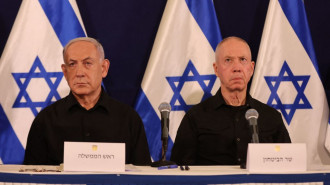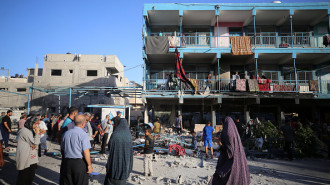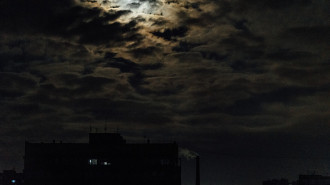'Sloppy' investigation clears killers of unarmed Palestinian boy
An Israeli military investigation into the killing of an unarmed Palestinian child in 2014, was "sloppy and partial", according to an Israeli human rights organisation.
5 min read
Palestinian youngsters run from Israeli security forces at the site Yusef al-Shawamreh was killed [Getty]
An Israeli military investigation that failed to hold anyone to account for the fatal shooting of an unarmed 14-year-old Palestinian boy was fundamentally flawed, according to the Israeli human rights organisation B'Tselem.
In March 2014, soldiers shot and killed Yusef al-Shawamreh as he squeezed through a gap in the Separation Barrier near the village of Deir al-Asal al-Foqa, southwest of Hebron, to pick fruit and edible plants on his family's land.
Although Shawamreh was shot in broad daylight and was not posing any danger, the investigation was closed without serving any indictments only four months after the killing.
Then-Military Advocate for Operational Matters Lieutenant Colonel Ronen Hirsch told B'Tselem there was "no suspicion that the open-fire regulations had been breached or that any military personnel were involved in criminal action".
In the statement, Hirsch wrote that four soldiers mounted an ambush after they spotted three Palestinians sabotaging and crossing the Separation Barrier.
The Israeli military claims the soldiers fired above the heads of the boys before opening live fire on them. One bullet fatally hit al-Shawamreh in the waist. Hirsch stated the soldiers had aimed for the child's legs.
B'Tselem obtained a partial copy of the investigation from the Military Advocate for Operational Matters. The NGO claims the investigation was both sloppy and partial.
According to the file, on 19 March 2014, three Palestinians - an 18-year-old and two minors - approached several gaps in the Separation Barrier that had long been used by Palestinian teenagers to cross through and pick edible Gundelia plants from their families' land on the other side.
The military had sealed the gaps in the fence with metal wire and plastic cable ties the previous evening.
When the three teenagers found the gaps closed, they began removing the wires and crossed the fence and the adjacent buffer zone. Only then did two of the soldiers reveal themselves.
The report says they called out to the boys to stop, fired two warning shots in the air, and then fatally shot 14-year-old Shawamreh.
An examination of the file found several flaws in the investigation, not least that it failed to hold to account any of the soldiers or their commanding officers.
No apparent attempt was made to reconcile the contradicting versions given by the suspects and by witnesses, and the responsibility of the commanders who decided to mount an armed ambush at the spot was utterly ignored.
For example, the investigators did not address the contradictions in the soldiers' accounts of their briefing on open-fire regulations.
WhatsApp correspondence between the soldiers throughout the incident showed that at least some of the soldiers believed the three Palestinians to be minors. However, they were not clear on the open-fire regulations applying to such circumstances.
The investigators made no attempt to get to the bottom of this important difference and they also ignored the fact that, in the context of a planned ambush, permission to shoot live fire at minors older then twelve is completely unlawful.
What motive?
The investigators also did not examine the purpose of mounting an ambush next to the Separation Barrier. The soldiers and their commanders claimed that the ambush was intended to prevent harm to the fence.
However, the soldiers did nothing to stop the sabotage. To the contrary, they waited until after the damage was done and only then revealed their presence and shot at the youngsters.
Sergeant Major Ofir, who commanded the ambush, told investigators that the shooting at Shawamreh was not unexpected, but the soldiers had prepared for just that.
He claimed that, when preparing for the ambush, the force made sure that all the gaps were sealed so that they could be certain anyone crossing the fence had sabotaged it.
That person would then be deemed "a fence saboteur" - and by definition suspected of committing an offence serious enough to warrant carrying out suspect-apprehension procedure, including opening fire at his legs.
Sergeant Major Ofir described how the marksman made sure when the ambush began that he had "a clean line of fire" to the sealed gaps in the fence.
The investigators did not ask the commander why he had decided, by sealing the gaps, to frame anyone crossing the fence as "suspected of a dangerous offence". They also did not question why the soldiers needed "a clean line of fire", as the heavily armed and armoured soldiers were perfectly capable of stopping anyone who approached the fence, and with less injurious means.
The deputy commander of Armor Battalion 77, Major Avishay, testified before the MPIU that the area in which the incident took place is known for frequent sabotage of the Separation Barrier to enable smuggling of goods from the West Bank into Israel.
He added that, in springtime, when Shawamreh was shot, the military knows that Palestinians frequently cross the fence to pick the Gundelia plants.
The decision to mount an ambush armed exclusively with live ammunition, the planning of a line of fire directed at anyone crossing the fence, and the vague open-fire orders that the soldiers received - all these suggest command responsibility for the shooting of Shawamreh, and yet the case was closed within months.
The policy of mounting ambushes armed only with live ammunition in the West Bank has led to the killing of at least seven Palestinians since the beginning of 2013.
In March 2014, soldiers shot and killed Yusef al-Shawamreh as he squeezed through a gap in the Separation Barrier near the village of Deir al-Asal al-Foqa, southwest of Hebron, to pick fruit and edible plants on his family's land.
Although Shawamreh was shot in broad daylight and was not posing any danger, the investigation was closed without serving any indictments only four months after the killing.
| Ambushes armed with only live ammunition in the West Bank have led to the killing of at least seven Palestinians since the beginning of 2013 |
Then-Military Advocate for Operational Matters Lieutenant Colonel Ronen Hirsch told B'Tselem there was "no suspicion that the open-fire regulations had been breached or that any military personnel were involved in criminal action".
In the statement, Hirsch wrote that four soldiers mounted an ambush after they spotted three Palestinians sabotaging and crossing the Separation Barrier.
The Israeli military claims the soldiers fired above the heads of the boys before opening live fire on them. One bullet fatally hit al-Shawamreh in the waist. Hirsch stated the soldiers had aimed for the child's legs.
B'Tselem obtained a partial copy of the investigation from the Military Advocate for Operational Matters. The NGO claims the investigation was both sloppy and partial.
According to the file, on 19 March 2014, three Palestinians - an 18-year-old and two minors - approached several gaps in the Separation Barrier that had long been used by Palestinian teenagers to cross through and pick edible Gundelia plants from their families' land on the other side.
The military had sealed the gaps in the fence with metal wire and plastic cable ties the previous evening.
When the three teenagers found the gaps closed, they began removing the wires and crossed the fence and the adjacent buffer zone. Only then did two of the soldiers reveal themselves.
The report says they called out to the boys to stop, fired two warning shots in the air, and then fatally shot 14-year-old Shawamreh.
|
|
||
| Footage of the fence crossing and ambush [B'Tselem] |
An examination of the file found several flaws in the investigation, not least that it failed to hold to account any of the soldiers or their commanding officers.
No apparent attempt was made to reconcile the contradicting versions given by the suspects and by witnesses, and the responsibility of the commanders who decided to mount an armed ambush at the spot was utterly ignored.
For example, the investigators did not address the contradictions in the soldiers' accounts of their briefing on open-fire regulations.
WhatsApp correspondence between the soldiers throughout the incident showed that at least some of the soldiers believed the three Palestinians to be minors. However, they were not clear on the open-fire regulations applying to such circumstances.
The investigators made no attempt to get to the bottom of this important difference and they also ignored the fact that, in the context of a planned ambush, permission to shoot live fire at minors older then twelve is completely unlawful.
What motive?
The investigators also did not examine the purpose of mounting an ambush next to the Separation Barrier. The soldiers and their commanders claimed that the ambush was intended to prevent harm to the fence.
However, the soldiers did nothing to stop the sabotage. To the contrary, they waited until after the damage was done and only then revealed their presence and shot at the youngsters.
Sergeant Major Ofir, who commanded the ambush, told investigators that the shooting at Shawamreh was not unexpected, but the soldiers had prepared for just that.
He claimed that, when preparing for the ambush, the force made sure that all the gaps were sealed so that they could be certain anyone crossing the fence had sabotaged it.
That person would then be deemed "a fence saboteur" - and by definition suspected of committing an offence serious enough to warrant carrying out suspect-apprehension procedure, including opening fire at his legs.
Sergeant Major Ofir described how the marksman made sure when the ambush began that he had "a clean line of fire" to the sealed gaps in the fence.
The investigators did not ask the commander why he had decided, by sealing the gaps, to frame anyone crossing the fence as "suspected of a dangerous offence". They also did not question why the soldiers needed "a clean line of fire", as the heavily armed and armoured soldiers were perfectly capable of stopping anyone who approached the fence, and with less injurious means.
The deputy commander of Armor Battalion 77, Major Avishay, testified before the MPIU that the area in which the incident took place is known for frequent sabotage of the Separation Barrier to enable smuggling of goods from the West Bank into Israel.
He added that, in springtime, when Shawamreh was shot, the military knows that Palestinians frequently cross the fence to pick the Gundelia plants.
The decision to mount an ambush armed exclusively with live ammunition, the planning of a line of fire directed at anyone crossing the fence, and the vague open-fire orders that the soldiers received - all these suggest command responsibility for the shooting of Shawamreh, and yet the case was closed within months.
The policy of mounting ambushes armed only with live ammunition in the West Bank has led to the killing of at least seven Palestinians since the beginning of 2013.





 Follow the Middle East's top stories in English at The New Arab on Google News
Follow the Middle East's top stories in English at The New Arab on Google News


